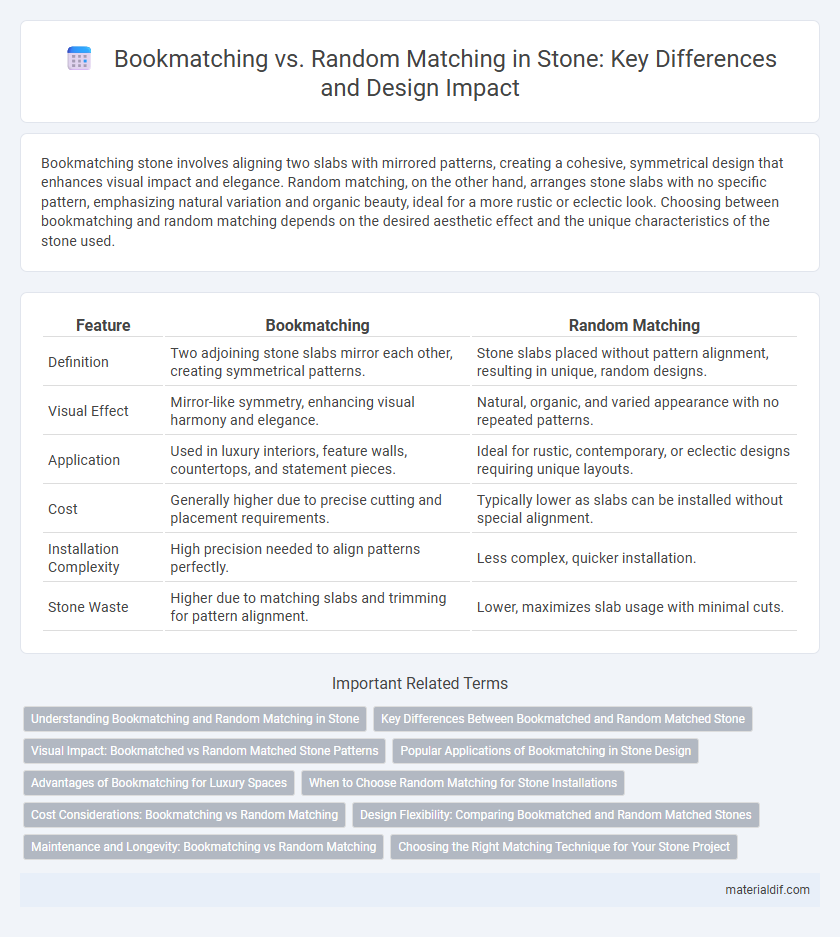Bookmatching stone involves aligning two slabs with mirrored patterns, creating a cohesive, symmetrical design that enhances visual impact and elegance. Random matching, on the other hand, arranges stone slabs with no specific pattern, emphasizing natural variation and organic beauty, ideal for a more rustic or eclectic look. Choosing between bookmatching and random matching depends on the desired aesthetic effect and the unique characteristics of the stone used.
Table of Comparison
| Feature | Bookmatching | Random Matching |
|---|---|---|
| Definition | Two adjoining stone slabs mirror each other, creating symmetrical patterns. | Stone slabs placed without pattern alignment, resulting in unique, random designs. |
| Visual Effect | Mirror-like symmetry, enhancing visual harmony and elegance. | Natural, organic, and varied appearance with no repeated patterns. |
| Application | Used in luxury interiors, feature walls, countertops, and statement pieces. | Ideal for rustic, contemporary, or eclectic designs requiring unique layouts. |
| Cost | Generally higher due to precise cutting and placement requirements. | Typically lower as slabs can be installed without special alignment. |
| Installation Complexity | High precision needed to align patterns perfectly. | Less complex, quicker installation. |
| Stone Waste | Higher due to matching slabs and trimming for pattern alignment. | Lower, maximizes slab usage with minimal cuts. |
Understanding Bookmatching and Random Matching in Stone
Bookmatching in stone involves cutting slabs from the same block and opening them like a book, creating a symmetrical and mirror-like pattern ideal for enhancing design continuity and visual impact. Random matching, by contrast, assembles slabs without regard to pattern alignment, resulting in a more organic and varied appearance well-suited for natural or rustic aesthetics. Understanding these techniques helps in selecting the appropriate stone layout to achieve desired design effects and optimize the use of material.
Key Differences Between Bookmatched and Random Matched Stone
Bookmatched stone involves pairing adjacent slabs from the same block, creating a mirror-like symmetrical pattern ideal for visually striking surfaces. Random matching uses non-sequential slabs, resulting in varied, unique patterns without symmetry, enhancing a natural and organic appearance. Bookmatching maximizes aesthetic continuity and design harmony, while random matching emphasizes individuality and texture diversity.
Visual Impact: Bookmatched vs Random Matched Stone Patterns
Bookmatched stone patterns create a symmetrical, mirror-image effect that enhances visual harmony and elegance, often preferred in high-end design for its balanced aesthetic. Random matched stone patterns, conversely, provide a more natural and organic look with unique variations, emphasizing texture and irregularity that highlight the stone's inherent character. The choice between bookmatching and random matching significantly influences the visual impact, with bookmatched patterns delivering dramatic continuity and random matching offering rustic authenticity.
Popular Applications of Bookmatching in Stone Design
Bookmatching in stone design creates visually striking patterns by aligning slabs mirror-like, enhancing aesthetic appeal in countertops, walls, and flooring. Popular applications include marble and granite installations where natural veins form symmetrical designs that add luxury and uniqueness to interior spaces. This technique contrasts with random matching, which arranges slabs without pattern continuity, often used for cost-efficiency rather than visual impact.
Advantages of Bookmatching for Luxury Spaces
Bookmatching creates a symmetrical and visually stunning stone pattern, enhancing the elegance and exclusivity of luxury spaces. This technique maximizes the natural veining and texture of marble or granite, resulting in a cohesive and harmonious design that elevates interior aesthetics. Unlike random matching, bookmatching offers a tailored and sophisticated appearance, making it ideal for high-end applications such as feature walls and statement countertops.
When to Choose Random Matching for Stone Installations
Random matching is ideal for stone installations where natural variation and unique character are prioritized over symmetry, making it perfect for rustic or organic design themes. This method suits irregularly sized slabs or projects with budget constraints since it requires less precise cutting and alignment. Stone surfaces like slate, limestone, or granite with distinct veining and texture benefit from random matching to emphasize authenticity and natural beauty.
Cost Considerations: Bookmatching vs Random Matching
Bookmatching involves aligning stone slabs to create mirrored patterns, which requires precise cutting and can increase labor and material costs due to higher waste and careful selection. Random matching allows for more flexible slab arrangement, reducing waste and typically lowering overall expenses by minimizing the need for consistent vein alignment. Cost considerations favor random matching in large-scale projects, while bookmatching is often reserved for high-end installations where aesthetic impact justifies the additional expense.
Design Flexibility: Comparing Bookmatched and Random Matched Stones
Bookmatched stones offer precise design symmetry by pairing adjacent slabs to create mirror-image patterns, enhancing aesthetic harmony in architectural applications. Random matching provides greater design flexibility with unique, non-repetitive patterns that emphasize natural stone variations for a more organic appearance. Selecting between bookmatched and random matched stones depends on the desired visual impact and project-specific design goals.
Maintenance and Longevity: Bookmatching vs Random Matching
Bookmatching stone surfaces offer enhanced structural integrity by aligning veins and patterns, which often reduces stress points and potential cracks over time, leading to easier maintenance and improved longevity. In contrast, random matching lacks this precise alignment, potentially increasing the likelihood of uneven wear and the need for more frequent repairs. Proper sealing and care remain essential for both methods, but bookmatched installations generally provide a more durable and visually cohesive surface.
Choosing the Right Matching Technique for Your Stone Project
Bookmatching creates symmetrical patterns by pairing consecutive stone slabs, ideal for projects requiring elegant and balanced aesthetics. Random matching showcases unique, non-repetitive stone variations, perfect for achieving a natural and organic look in your space. Selecting the right technique depends on the desired visual impact and project style, ensuring stone surfaces complement architectural design flawlessly.
Bookmatching vs Random Matching Infographic

 materialdif.com
materialdif.com